Scag Power Equipment Liberty Z SZL52-24KT User manual
- Category
- Lawnmowers
- Type
- User manual
This manual is also suitable for

PART NO. 03377
PRINTED 1/2015
PRINTED IN USA
© 2015
Scag Power Equipment
Division of Metalcraft of Mayville, Inc.
Congratulations on owning a Scag mower! This manual contains the operating
instructions and safety information for your Scag mower. Reading this manual
can provide you with assistance in maintenance and adjustment procedures to
keep your mower performing to maximum efciency. The specic models that
this book covers are listed on the inside cover. Before operating your machine,
please read all the information enclosed.
OPERATOR’S
MANUAL
Liberty Z
Models: SZL48-22KT
SZL52-24KT

WARNING
FAILURE TO FOLLOW SAFE OPERATING PRACTICES MAY RESULT
IN SERIOUS INJURY OR DEATH.
Read this manual completely as well as other manuals that came with your mower.•
DO NOT operate on steep slopes. To check a slope, attempt to back up it (with the •
cutter deck down). If the machine can back up the slope without the wheels slipping,
reduce speed and use extreme caution.
Under no circumstances should the machine be operated on slopes greater than 15 •
degrees. ALWAYS FOLLOW OSHA APPROVED OPERATION.
Stay two cut widths away from slopes, drop offs, ditches and retaining walls.•
DO NOT mow on wet grass. Wet grass reduces traction and steering control.•
Keep all shields in place, especially the grass discharge chute.•
Before performing any maintenance or service, stop the machine and remove the •
spark plug wire and ignition key.
If a mechanism becomes clogged, stop the engine before cleaning.•
Keep hands, feet and clothing away from power-driven parts.•
Keep others off the mow• er (only one person at a time).
REMEMBER - YOUR MOWER IS ONLY AS SAFE AS THE OPERATOR!
HAZARD CONTROL AND ACCIDENT PREVENTION ARE DEPENDENT UPON THE AWARENESS,
CONCERN, PRUDENCE, AND PROPER TRAINING OF THE PERSONNEL INVOLVED IN THE
OPERATION, TRANSPORT, MAINTENANCE, AND STORAGE OF THE EQUIPMENT.
This manual covers the operating instructions and illustrated parts list for:
SZL48-22KT with a serial number of K7100001 to K7199999
SZL52-24KT with a serial number of K7200001 to K7299999
Always use the entire serial number listed on the serial number tag when referring to this product.

I
R
Table of Contents
Table of Contents
GENERAL INFORMATIONSECTION 1 - ...................................................................................1
1.1 INTRODUCTION ...........................................................................................................................................1
1.2 DIRECTION REFERENCE ...........................................................................................................................1
1.3 SERVICING THE ENGINE AND DRIVE TRAIN COMPONENTS .................................................................1
1.4 SYMBOLS ....................................................................................................................................................2
SAFETY INFORMATIONSECTION 2 - ......................................................................................3
2.1 IMPORTANT SAFETY PRACTICES FOR RIDE-ON MOWERS ..................................................................3
2.2 INTRODUCTION ...........................................................................................................................................3
2.3 SIGNAL WORDS ..........................................................................................................................................3
2.4 CHILDREN ...................................................................................................................................................3
2.5 BEFORE OPERATION CONSIDERATIONS ................................................................................................4
2.6 SAFE HANDLING OF GASOLINE ...............................................................................................................5
2.7 OPERATION CONSIDERATIONS ................................................................................................................5
2.8 TRANSPORTING THE MOWER ...................................................................................................................6
2.9 MAINTENANCE CONSIDERATIONS & STORAGE ....................................................................................7
2.10 USING A SPARK ARRESTOR ...................................................................................................................8
2.11 SPARK IGNITION SYSTEM .......................................................................................................................8
2.12 SAFETY DECAL LOCATION .....................................................................................................................9
SPECIFICATIONSSECTION 3 - ..............................................................................................10
3.1 ENGINE ......................................................................................................................................................10
3.2 ELECTRICAL .............................................................................................................................................10
3.3 MOWER ......................................................................................................................................................10
3.4 CUTTER DECK ..........................................................................................................................................11
3.5 HYDRAULIC SYSTEM ...............................................................................................................................11
3.6 WEIGHTS AND DIMENSIONS ...................................................................................................................11
3.7 PRODUCTIVITY .........................................................................................................................................11
OPERATING INSTRUCTIONSSECTION 4 - ...........................................................................12
4.1 CONTROLS AND INSTRUMENT IDENTIFICATION ................................................................................12
4.2 SAFETY INTERLOCK SYSTEM ................................................................................................................13
4.3 INITIAL RUN-IN PROCEDURES ................................................................................................................14
4.4 STARTING THE ENGINE ...........................................................................................................................14
4.5 GROUND TRAVEL AND STEERING .........................................................................................................14
4.6 ENGAGING THE DECK DRIVE (CUTTER BLADES) ................................................................................16
4.7 SLOPE OPERATION ..................................................................................................................................16
4.8 PARKING THE MOWER .............................................................................................................................17
4.9 AFTER OPERATION ..................................................................................................................................17
4.10 REMOVING CLOGGED MATERIAL ........................................................................................................18
4.11 MOVING MOWER WITH ENGINE STOPPED ..........................................................................................18
4.12 RECOMMENDATIONS FOR MOWING ....................................................................................................18
4.13 ADJUSTING CUTTING HEIGHT ..............................................................................................................18
4.14 TOWING (OPTIONAL HITCH ACCESSORY)...........................................................................................19

II
R
Table of Contents
TROUBLESHOOTING CUTTING CONDITIONSSECTION 5 - ...............................................20
ADJUSTMENTSSECTION 6 - .................................................................................................23
6.1 PARKING BRAKE ADJUSTMENT ............................................................................................................23
6.2 TRACKING ADJUSTMENT ........................................................................................................................24
6.3 THROTTLE CONTROL AND CHOKE ADJUSTMENTS ............................................................................24
6.4 BELT ADJUSTMENT .................................................................................................................................24
6.5 BELT ALIGNMENT .....................................................................................................................................25
6.6 CUTTER DECK ADJUSTMENTS ..............................................................................................................25
MAINTENANCESECTION 7 - ..................................................................................................28
7.1 MAINTENANCE CHART - RECOMMENDED SERVICE INTERVALS ......................................................28
7.2 GREASE FITTING LOCATION CHART .....................................................................................................29
7.3 HYDRAULIC SYSTEM ...............................................................................................................................30
7.4 ENGINE OIL ..............................................................................................................................................31
7.5 ENGINE FUEL SYSTEM ............................................................................................................................32
7.6 ENGINE AIR CLEANER .............................................................................................................................34
7.7 BATTERY ....................................................................................................................................................34
7.8 DRIVE BELTS .............................................................................................................................................35
7.9 CUTTER BLADES ......................................................................................................................................35
7.10 TIRES ........................................................................................................................................................37
7.11 BODY, DECK, AND UPHOLSTERY .........................................................................................................37
ILLUSTRATED PARTS LISTSECTION 8 - ..............................................................................38
8.1 SCAG APPROVED ATTACHMENTS AND ACCESSORIES. .....................................................................38
NOTES ..............................................................................................................................................................39
48 & 52 CUTTER DECKS ................................................................................................................................40
CUTTER DECK CONTROLS ...........................................................................................................................42
SHEET METAL COMPONENTS ......................................................................................................................44
DRIVE SYSTEM COMPONENTS ....................................................................................................................46
ELECTRICAL SYSTEM ...................................................................................................................................48
FUEL SYSTEM .................................................................................................................................................50
REPLACEMENT DECALS AND INFORMATION PLATES .............................................................................52
ELECTRICAL SCHEMATIC .............................................................................................................................54
LIMITED WARRANTY - SZL ........................................................................................... INSIDE BACK COVER

1
R
Section 1
INTRODUCTION1.1
Your mower was built to the highest standards in the
industry. However, the prolonged life and maximum
efficiency of your mower depends on you following the
operating, maintenance and adjustment instructions in
this manual.
If additional information or service is needed, contact your
Scag Power Equipment Dealer.
We encourage you to contact your dealer for repairs. All
Scag dealers are informed of the latest methods to service
this equipment and provide prompt and efficient service in
the field or at their service shop. They carry a full line of
Scag service parts.
THE REPLACEMENT OF ANY PART ON THIS PRODUCT
BY OTHER THAN THE MANUFACTURER'S AUTHORIZED
REPLACEMENT PART MAY ADVERSELY AFFECT THE
PERFORMANCE, DURABILITY OR SAFETY OF THIS
PRODUCT.
USE OF OTHER THAN ORIGINAL SCAG REPLACEMENT
PARTS WILL VOID THE WARRANTY.
When ordering parts, always give the model and serial
number of your mower. The serial number plate is located
on the right side on the frame. Lift the seat to locate the
serial number plate. See Figure 1-1.
Mower Serial Number Plate LocationFigure 1-1.
GENERAL INFORMATION
USE ONLY SCAG APPROVED ATTACHMENTS AND
ACCESSORIES.
Attachments and accessories manufactured by companies
other than Scag Power Equipment are not approved for use
on this machine. See Section 8, Paragraph 8-1.
WARNING
For pictorial clarity, some illustrations and figures
in this manual may show shields, guards or plates
open or removed. Under no circumstances should
your mower be operated without these devices
in place.
All information is based upon product information available
at the time of approval for printing. Scag Power Equipment
reserves the right to make changes at any time without
notice and without incurring any obligation.
DIRECTION REFERENCE1.2
The “Right” and “Left”, “Front” and “Rear” of the machine are
referenced from the operator’s right and left when seated
in the normal operating position and facing the forward
travel direction.
SERVICING THE ENGINE AND DRIVE 1.3
TRAIN COMPONENTS
The detail servicing and repair of the engine, hydraulic
pumps and gearboxes are not covered in this manual;
only routine maintenance and general service instructions
are provided. For service of these components during
the limited warranty period, it is important to contact your
Scag dealer or find a local authorized servicing agent of
the component manufacturer. Any unauthorized work done
on these components during the warranty period may void
your warranty.

2
R
Section 1
SYMBOLS1.4
SYMBOL DESCRIPTION SYMBOL DESCRIPTION
Choke
Transmission
Parking Brake
48071S
Spinning Blade
On/Start
Spring Tension on Idler
Off/Stop
Oil
Falling Hazard
Thrown Object Hazard
Fast
Slow
Continuously Variable - Linear
Cutting Element - Basic Symbol
481039S
Pinch Point
Cutting Element - Engage
Hour meter/Elapsed Operating Hours
Cutting Element - Disengage
Keep Bystanders Away
Read Operator's Manual

3
R
Section 2
IMPORTANT SAFETY PRACTICES FOR 2.1
RIDE-ON MOWERS
This cutting machine is capable of amputating hands and
feet and throwing objects. Failure to observe the following
safety instructions could result in serious injury or death.
INTRODUCTION2.2
Your mower is only as safe as the operator. Carelessness
or operator error may result in serious bodily injury
or death. Hazard control and accident prevention are
dependent upon the awareness, concern, prudence, and
proper training of the personnel involved in the operation,
transport, maintenance and storage of the equipment. Make
sure every operator is properly trained and thoroughly
familiar with all of the controls before operating the
mower. The owner/user can prevent and is responsible for
accidents or injuries occurring to themselves, other people
or property.
READ, UNDERSTAND AND FOLLOW ALL INSTRUCTIONS
ON THE MACHINE AND IN THIS OPERATOR’S MANUAL
BEFORE ATTEMPTING TO START YOUR MOWER.
A replacement manual is available from your authorized
Scag Service Dealer or by contacting Scag Power
Equipment, Service Department at P.O. Box 152, Mayville,
WI 53050 or contact us via the Internet at www.scag.com.
The manual for this machine can be downloaded by using
the model and serial number or use the contact form to
make your request. Please indicate the complete model
and serial number of your Scag product when requesting
replacement manuals.
SIGNAL WORDS2.3
This symbol means “Attention! Become Alert! Your
Safety is Involved!" The symbol is used with the following
signal words to attract your attention to safety messages
found on the decals on the machine and throughout this
manual. The message that follows the symbol contains
important information about safety. To avoid injury and
possible death, carefully read the message! Be sure to fully
understand the causes of possible injury or death.
SIGNAL WORD:
It is a distinctive word found on the safety decals on the
machine and throughout this manual that alerts the viewer
to the existence and relative degree of the hazard.
DANGER
The signal word “DANGER” denotes that an extremely
hazardous situation exists on or near the machine that
could result in high probability of death or irreparable injury
if proper precautions are not taken.
WARNING
The signal word “WARNING” denotes that a hazard exists
on or near the machine that can result in injury or death if
proper precautions are not taken.
CAUTION
The signal word “CAUTION” is a reminder of safety practices
on or near the machine that could result in personal injury
if proper precautions are not taken.
Your safety and the safety of others depends significantly
upon your knowledge and understanding of all correct
operating practices and procedures of this machine.
CHILDREN2.4
Tragic accidents can occur if the operator is not alert to the
presence of children. Children are often attracted to the
machine and mowing activity. They don't understand the
dangers of rotating blades or the fact that the operator is
unaware of their presence. Never assume that the children
will remain where you saw them.
NEVER allow children to operate this riding mower.1.
Do not mow when children and/or others are 2.
present. Keep children indoors, out of the mowing
area and in the watchful care of a responsible adult,
other than the operator, when the mower is being
operated.
SAFETY INFORMATION

4
R
Section 2
Be alert and turn machine off if a child or other 3.
person enters the area.
DO NOT allow children to ride or play on the 4.
machine, it is not a toy.
Instruct all operators not to give children a ride on 5.
machine or attachment.
NEVER carry children on a machine or attachment, 6.
even with the blades off.
DO NOT tow children in a cart or trailer. They can 7.
fall off and be seriously injured or interfere with safe
machine operation.
Children who have been given rides in the past may 8.
suddenly appear in the mowing area for another ride
and be run over or backed over by the machine.
NEVER use the machine as a recreational vehicle or 9.
to entertain children.
Use extreme care when approaching blind corners, 10.
shrubs, trees, or other objects that may block your
view of a child.
Before and while backing, look behind and down for 11.
small children.
BEFORE OPERATION 2.5
CONSIDERATIONS
WARNING
Check all hydraulic connections for tightness.
Inspect all hydraulic hoses and / or lines to insure
they are in good condition before operating.
Data indicates operators age 60 years and above 1.
are involved in a larger percentage of riding mower
related injuries. These operators should evaluate
their ability to operate the riding mower safely
enough to protect themselves and others from
serious injury.
Maintain or replace safety and instruction labels as 2.
necessary.
Only allow responsible adults who are familiar with 3.
the instructions to operate the machine.
Be sure area is clear of bystanders before operating. 4.
Stop the machine if anyone enters the area.
Clear the area to be mowed of objects that could be 5.
picked up and thrown by the cutter blades such as
rocks, wire, toys, etc.
DO NOT carry passengers.6.
DO NOT operate the machine under the influence of 7.
alcohol or drugs.
If the operator(s) or mechanic(s) cannot read 8.
English, it is the owner's responsibility to explain this
material to them.
DO NOT wear loose fitting clothing. Loose clothing, 9.
jewelry or long hair could get tangled in moving
parts. Do not operate the machine wearing shorts;
always wear adequate protective clothing including
long pants. Wearing safety shoes and a helmet is
advisable and is required by some local ordinances
and insurance regulations.
WARNING
Always wear eye and hearing protection when
operating. Operating this machine over prolonged
periods of time can cause loss of hearing.
Keep the machine and attachments in good 10.
operating condition. Keep all shields and safety
devices in place. If a shield, safety device or decal
is defective or damaged, repair or replace it before
operating the machine.
Check grass catcher components and discharge 11.
guard frequently and replace with manufacturer's
recommended parts only, when necessary.
Never interfere with the intended function of a safety 12.
device or reduce the protection provided by the
safety device. Check their proper operation regularly.
WARNING
This machine is equipped with an interlock system
intended to protect the operator and others from
injury. This is accomplished by preventing the
engine from starting unless the deck drive is
disengaged, the steering control levers are in the
neutral position and the operator is in the seat.
The system shuts off the engine if the operator
leaves the seat with the deck drive engaged and/
or the steering control levers are not in the neutral
position and the parking brake is not engaged.
Never operate equipment with the interlock
system disconnected or malfunctioning.

5
R
Section 2
Test the operation of the safety interlock system. See 13.
Section 4.2, Page 13.
Be sure the interlock switches are functioning 14.
correctly.
Equipment must comply with the latest requirements 15.
per SAE J137 and/or ANSI/ASAE S279 when driven
on public roads.
- NOTE -
If the mower is driven on public roads, it must
comply with state and local ordinances as well as
SAE J137 and/or ANSI / ASAE S279 requirements.
Contact your local authorities for regulations and
equipment requirements.
Do not operate without the side discharge chute 16.
installed and in the down position or with an optional
grass catcher or mulch plate completely installed.
Check the blade mounting bolts at frequent intervals 17.
for proper tightness.
Make sure all hydraulic fluid connections are tight 18.
and all hydraulic hoses and lines are in good
condition before starting the machine.
SAFE HANDLING OF GASOLINE2.6
To avoid personal injury or property damage, use extreme
care in handling gasoline. Gasoline is extremely flammable
and the vapors are explosive.
See Section 7.4 ENGINE FUEL SYSTEM for fueling 1.
procedure.
Fuel is flammable; handle it with care. Clean up any 2.
spilled fuel immediately. If fuel spills on clothing,
change clothing immediately. If fuel is spilled near
the machine, DO NOT attempt to start the engine but
move the machine away from the area of spillage.
Avoid creating any source of ignition until fuel vapors
have dissipated.
Prevent fire and explosion caused by static electric 3.
discharge. Static electric discharge can ignite fuel
vapors in an ungrounded fuel container.
Never store the machine or fuel container where 4.
there is an open flame, spark, or pilot light such as a
water heater or other appliances.
Extinguish all cigarettes, cigars, pipes, and other 5.
sources of ignition.
Keep flammable objects (cigarettes, matches, etc.), 6.
open flames and sparks away from the fuel tank and
fuel container.
Use only approved containers. Use only non-7.
metal, portable fuel containers approved by the
Underwriter's Labratory (U.L.) or the American
Soceity for Testing & Materials (ASTM).
OPERATION CONSIDERATIONS2.7
Know the function of all controls and how to stop 1.
quickly.
NEVER operate the machine in a closed area.2.
Keep hands and feet away from cutter blades. 3.
Contact can injure.
DO NOT put hands or feet near rotating parts or 4.
under the machine.
Keep clear of the discharge opening.5.
Follow the manufacturer's recommendations for 6.
wheel weights and counterweights.
WARNING
DO NOT operate on steep slopes. To check a slope,
attempt to back up it (with the cutter deck down).
If the machine can back up the slope without the
wheels slipping, reduce speed and use extreme
caution. Under no circumstances should the
machine be operated on slopes greater than 15
degrees. See Figure 2-1, Page 7 to determine
approximate slope of area to be mowed. ALWAYS
FOLLOW OSHA APPROVED OPERATION.
Reduce speed and exercise extreme caution on 7.
slopes and in sharp turns to prevent tipping or loss
of control. Be especially cautious when changing
directions on slopes.
Stay two cut widths away from slopes, drop offs, 8.
ditches and retaining walls.
To prevent tipping or loss of control, start and stop 9.
smoothly, avoid unnecessary turns and travel at
reduced speed. Use caution when operating the
mower on an incline with the optional grass catcher
installed.
Immediately apply the parking brake if you lose 10.
steering control while operating. Inspect the machine
and correct the problem before continuing to operate.
Never direct the discharge of material toward 11.
anyone. Avoid discharging material against a wall
or obstruction. Material may ricochet back toward
operator.

6
R
Section 2
The machine and attachments should be stopped 24.
and inspected for damage after striking a foreign
object, and damage should be repaired before
restarting and operating the machine.
CAUTION
Do not touch the engine or the muffler while the
engine is running or immediately after stopping.
These areas may be hot enough to cause a
burn.
DANGER
DO NOT run the engine inside a building or
a confined area without proper ventilation.
Exhaust fumes are hazardous and contain
carbon monoxide which can cause brain injury
and death.
Use care when approaching blind corners, shrubs, 25.
trees, or other objects that may obscure vision.
TRANSPORTING THE MOWER2.8
Transport the mower using a heavy duty trailer 1.
or truck. Insure the trailer or truck has all of the
necessary lighting and markings as required by
laws, codes, and ordinances. Secure a trailer with a
safety chain.
Be cautious when loading and unloading onto 2.
trailers or trucks. Use only a full width ramp. Ramp
angle should be no more than 15 degrees. Back up
the ramp and drive down forward.
When transporting the mower, make sure the park 3.
brake is engaged, the steering control levers are in
the neutral position, the engine is off with the key
removed, and the wheels have been blocked.
Tie the mower down securely using straps, chains, 4.
cable, or ropes. Both front and rear straps must be
directed down and outward from machine.
Before attempting to start the engine, with the 12.
operator in the seat, disengage power to the cutter
deck, place the steering control levers in the neutral
position and engage the parking brake.
Shut off the engine, remove the ignition key, and 13.
wait for all movement to stop before cleaning the
machine, removing grass catcher or unclogging the
discharge guard.
WARNING
DO NOT use your hand to dislodge the clogged
discharge chute. Use a stick or other device to
remove clogged material after the engine has
stopped running and the blades have stopped
turning.
Be alert for holes, rocks, roots and other hidden 14.
hazards in the terrain. Keep away from any drop-offs.
Beware of overhead obstructions (low limbs, etc.)
and underground obstacles (sprinklers, pipes, tree
roots, etc.). Cautiously enter a new area. Be alert for
hidden hazards.
Disengage power to cutter deck before backing up. 15.
Do not mow in reverse unless absolutely necessary
and then only after observation of the entire area
behind the mower. If you must mow in reverse,
maintain a constant lookout to the rear of the
machine and mow slowly.
DO NOT turn sharply. Use care when backing up.16.
Disengage power to cutter deck before crossing 17.
roads, walks or gravel drives.
Watch for traffic when operating near or crossing 18.
roadways.
Mow only in daylight or good artificial light.19.
NEVER raise the deck with the blades engaged.20.
NEVER leave the machine running unattended. 21.
Disengage the mower, lower the attachments, set 22.
the parking brake, stop the engine, and remove the
key before dismounting.
Disengage power to the attachments when 23.
transporting or when not in use.

7
R
Section 2
5
o
10
o
15
o
20
o
Figure 2-1.
WARNING
Be cautious when loading and unloading onto
trailers or trucks.
Use only a full width ramp.
Ramp angle should be no more than 15 Degrees.
See Figure 2-1 to help determine approximate
slope.
Back up the ramp and drive down forward.
MAINTENANCE CONSIDERATIONS & 2.9
STORAGE
Never make adjustments to the machine with the 1.
engine running unless specifically instructed to do
so. If the engine is running, keep hands, feet, and
clothing away from moving parts.
Disengage drives, lower implement, set parking 2.
brake, stop engine and remove key or disconnect
spark plug wire to prevent accidental starting of the
engine when servicing or adjusting the machine.
Wait for all movement to stop before adjusting,
cleaning or repairing.
Disconnect battery or remove spark plug wire before 3.
making any repairs. Disconnect the negative terminal
first and the positive last. Reconnect the positive first
and the negative last.
Keep all nuts, bolts and screws tight, to ensure the 4.
machine is in safe working condition. Check blade
mounting bolts frequently to be sure they are tight.
Do not change the engine governor settings or 5.
overspeed the engine. See the engine operator's
manual for information on engine settings.
To reduce fire hazard, keep the cutting units, drives, 6.
muffler and engine free of grass, leaves, excessive
grease, oil and dirt. Clean up oil or fuel spillage and
remove any fuel soaked debris. Allow the machine to
cool before storing.
Park the machine on level ground and engage the 7.
parking brake.
NEVER allow untrained personnel to service the 8.
machine.
Use care when checking blades. Use a Blade Buddy, 9.
wrap the blade(s) or wear gloves and USE CAUTION
when servicing blades. Only replace blades. NEVER
straighten or weld blades.
Keep all parts in good working condition. Replace all 10.
worn or damaged decals.
Use jack stands to support components when 11.
required.
Carefully release pressure from components with 12.
stored energy.
WARNING
Hydraulic fluid is under high pressure and can
penetrate skin causing injury. If hydraulic fluid
is injected into the skin, it must be surgically
removed within a few hours by a doctor or
gangrene may result.
Keep body and hands away from pinholes or
nozzles that eject hydraulic fluid under high
pressure. Use paper or cardboard and not hands
to search for leaks.
Safely relieve all pressure from the hydraulic
system by placing the control levers in the neutral
lock position and shutting off the engine before
performing any work on the hydraulic system.
If you need service on your hydraulic system,
please see your authorized Scag dealer.
Let the engine cool before storing.13.
DO NOT store the machine near an open flame.14.
Shut off fuel while storing or transporting.15.
DO NOT store fuel near flames or drain indoors.16.

8
R
Section 2
Charge batteries in an open, well ventilated area, 17.
away from spark and flames. Unplug charger before
connecting or disconnecting from battery. Wear
protective clothing and use insulated tools.
USING A SPARK ARRESTOR2.10
The engine in this machine is not equipped with a spark
arrestor muffler. It is in violation of California Public
Resource Code Section 4442 to use or operate this engine
on or near any forest covered, brush covered or grass
covered land unless the exhaust system is equipped with
a spark arrestor meeting any applicable local or state laws.
Other states or federal areas may have similar laws. Check
with your state or local authorities for regulations pertaining
to these requirements.
SPARK IGNITION SYSTEM2.11
This spark ignition system complies with Canadian
ICES-002.

9
R
Section 2
SAFETY DECAL LOCATION2.12
DANGER
WARNING
WARNING
WARNING
DANGER
DANGER
DANGER
(under seat)
WARNING
483505
483402
483505
483406
483402
483505
(molded into tank)
485371
(molded into tank)

10
R
Section 3
SPECIFICATIONS
ENGINE3.1
General Type ................................................................................................Heavy Duty Industrial/Commercial Gasoline
Model:
Scag Model SZL48-22KT ....................................................................................................................... Kohler KT725
Scag Model SZL52-24KT ....................................................................................................................... Kohler KT735
Displacement:
Kohler KT725 / KT735 ........................................................................................................................................ 725cc
Type ..........................................................................................................4 Cycle Gasoline, Twin Cylinder, Vertical Shaft
Cylinders ..................................................................................................................................... 2 with Cast Iron Sleeves
Governor ........................................................................Mechanical Type with Variable Speed Control Set At 3600 RPM
Idle Speed:
Kohler .......................................................................................................................................................... 1750 RPM
Fuel Pump ...................................................................................................... Integral Fuel Pump with In-Line Fuel Filter
Fuel ...................................................................................... Non-Leaded Gasoline with a Minimum Octane Rating of 87
Oil Pump ........................................................................................................................ Positive Displacement Gerotor™
Starter: .............................................................................................................. Electric Starting with Bendix Shift Starter
Belts .................................................................................................................Kevlar cord. Self-adjusting, Self-tightening
ELECTRICAL3.2
Battery .................................................................................................................................................................... 12 Volt
Charging System ............................................................................................................................................... Alternator
Charging Output:
Kohler .................................................................................................................................................. 12 Volt, 12 Amp
System Polarity ....................................................................................................................................... Negative Ground
Starter .......................................................................................................12 Volt Electric Ring Gear Type, Key Operated
Interlock Switches ....................................................... Seat, Neutral Control, Mower Engagement (BBC), Parking Brake
Instrument Panel .....................................................Key Switch, Throttle Lever, Manual Choke, PTO Switch, Hourmeter
Fuses ........................................................................................................................................................Two (2) 20 Amp
MOWER3.3
Drive System ......................................................... Hydraulic Drive with Two Hydro-Gear™ Integraded Zero-Turn Axles
Scag Models (SZL48-22KT, SZL52-24KT) ...............................................................................Hydro-Gear™ ZT-2800
Steering/Travel Control ........................................................................................... Twin Lever Fingertip Steering Control
with Individual Control to Each Wheel with Gas Spring Dampers
Parking Brake ...................................................................Lever Actuated Linkage to Brakes on Both Drive Wheel Axles
Wheels:
(2) Front Caster ............................................................................................................................... 11 X 4 - 5 Two-Ply
(2) Drive - .............................................................................. 20 X 10-8 Four-Ply Pneumatic Tubeless, Radius Edge
Tire Pressure:
Front Caster....................................................................................................................................................... 25 PSI
Drive .................................................................................................................................................................... 8 PSI
Fuel Tank .................................. Single 5-1/2 Gallon High Density Polyetholene Tank with Large Opening and Fuel Cap
Seat .................................................................................................... Padded, Thick Cushion with Extra Spring Support
Travel Speed:
Forward ................................................................................................................................................. 0 up to 7 MPH
Reverse ................................................................................................................................................. 0 up to 4 MPH
-NOTE- The machine will travel up to 8 mph for transport purposes. For best cutting performance the forward travel
speed should be adjusted depending upon the cutting conditions.

11
R
Section 3
CUTTER DECK3.4
Type ......................... Floating, Adjustable, Anti-Scalping, Hybrid Design Combines Out-Front and Belly-Mount Designs
Construction ...............................................................................10-Gauge top with 11-Gauge reinforcement throughout
the spindle area, 10-Gauge skirt for strength and longevity
True Cutting Width:
48 ..........................................................................................................................................................48" (122.0 cm)
52 ..........................................................................................................................................................52" (132.0 cm)
Cutting Height Adjustment ...........Foot-Operated Lever Adjustment from Operator's Seat, 1.5" to 4.5" in 1/4"increments
Cutter Blades ............................................................................. 0.197 in. Thick, Milled Edge, Wear Resistant Marbain™
Blade Engagement ............................................................Electric Blade Engagement Clutch with Control Panel Switch
Connected to the Cutter Deck through a Belt.
Discharge Opening ............................................... Extra Wide Discharge Opening with Spring-Loaded Discharge Chute
Discharge Chute ...................................................................................................Black, Polypropylene (Plastic), Flexible
Spindles ...........................Heavy-Duty Spindle Shaft, Cast Aluminum Housing, Sealed Ball Bearing, Maintenance-Free
Spindle Pulleys ..................................................................................................................................................Split Steel
Cutter Deck Belts ...................................................................B-section with Kevlar Cord. Self-Adjusting, Self-Tightening
Electric Clutch Type ................................................................................................Ogura Heavy Duty PTO Clutch Brake
HYDRAULIC SYSTEM3.5
Hydraulic Oil Filter ......................................................................................................... 40 Micron Spin-on Element Type
Hydraulic Expansion Reservoir ................................................................................................................................Nylon
WEIGHTS AND DIMENSIONS 48 523.6
Length................................................................................................................................ 73" ....................................73"
Tracking Width ..................................................................................................................47.5" ................................47.5"
Overall Width w/chute down .............................................................................................60.5" ................................64.5"
Overall Width w/chute up ................................................................................................... 49" ....................................53"
Overall Height .................................................................................................................... 43" ....................................43"
Operating Weight .............................................................................................................. 610# ................................ 640#
PRODUCTIVITY 48 523.7
Cutting Width ..................................................................................................................... 48" ....................................52"
Acres Per Day ................................................................................................................... 18.6 .................................. 20.2
The preceding chart will aid you in determining how many acres your Scag mower will cut per day. The chart is an
estimate based on 8 hours per day cutting time at 6 MPH with a 20% allowance for overlap and turns.

12
R
Section 4
WARNING
Do not attempt to operate this mower unless you
have read this manual. Learn the location and
purpose of all controls and instruments before
you operate this mower.
CONTROLS AND INSTRUMENT 4.1
IDENTIFICATION
Before operating the mower, familiarize yourself with all
mower and engine controls. Knowing the location, function
and operation of these controls is important for safe and
efficient operation of the mower.
OPERATING INSTRUCTIONS
Ignition Switch (Figure 4-1).1. The ignition switch
is used to start the engine and has three positions;
OFF, ON, and START.
Mower Deck Switch (Figure 4-1). 2. Used to engage
and disengage the mower drive system. Pulling up
on the switch will engage the deck drive. Pushing
down on the switch will disengage the deck drive.
Engine Choke Control (Figure 4-1).3. Used to start
a cold engine.
Engine Throttle Control (Figure 4-1).4. Used to
control the engine speed. Pushing the lever forward
increases engine speed. Pulling the lever back
decreases engine speed. Full back position is the
IDLE position. Full forward is the cutting position.
DUMP VALVE
DUMP VALVE
CUTTING HEIGHT
ADJUSTMENT
DECK LIFT
PARKING
BRAKE
MOWER
DECK
SWITCH
ENGINE
CHOKE
CONTROL
ENGINE
THROTTLE
CONTROL
IGNITION
SWITCH
HOUR METER
LEFT STEERING
CONTROL
RIGHT STEERING
CONTROL
FUSES
Controls and InstrumentsFigure 4-1.

13
R
Section 4
Hourmeter (Figure 4-1).5. Indicates the number of
hours the engine has been operated. It operates
whenever the engine is running. Has preset
maintenance reminders for engine and hydraulic
system oil changes. Will start flashing scheduled
maintenance 2 hours before preset time and
continue flashing until 2 hours after. Automatically
resets.
Fuse Holders (Figure 4-1). 6. Two 20-amp fuses
protect the mower’s electrical system. To replace
fuses, pull fuse out of the socket and install a new
fuse.
Left Steering Control (Figure 4-1). 7. Used to control
the mower's left wheel when traveling forward or
reverse.
Right Steering Control (Figure 4-1).8. Used to
control the mower's right wheel when traveling
forward or reverse.
Parking Brake Control (Figure 4-1). 9. Used to
engage and disengage the parking brakes. Pull the
lever back to engage the parking brakes. Push the
lever forward to disengage the parking brakes.
Dump Valve Control Levers (Figure 4-2). 10. Located
on the left and right side at the back of the unit,
used to “free-wheel” the mower. Pushing the levers
forward (towards the front of the mower) allows
the unit to move under hydraulic power. Pulling the
levers backward and locking in the notch (towards
the rear of the mower and inward) allows the mower
to be moved by hand (free-wheeling).
2014 SZL-DVL
DUMP VALVE
CONTROL LEVER
"DRIVE" POSITION
Dump Valve ControlFigure 4-2.
Deck Lift Foot Lever (Figure 4-1). 11. Used to raise
and lower the cutter deck.
Cutting Height Adjustment (Figure 4-1).12. Used to
set the cutter deck at the desired cutting height.
SAFETY INTERLOCK SYSTEM4.2
The mower is equipped with a safety interlock system that
prevents the engine from starting unless the deck drive is
disengaged, the steering control levers are in the neutral
position and the operator is in the seat. The interlock
system shuts off the engine if the operator leaves the seat
with the steering control levers not in the neutral position
and/or the cutter blades engaged and the parking brake
not engaged.
WARNING
Never operate the mower with the interlock
system disconnected or malfunctioning. Do not
disengage or bypass any switch; injury to yourself
and others or property damage could result.
Test the safety interlock system before you use the
machine each time. If the safety interlcok system does
not operate as descibed below, contact your local Scag
Power Equipment Dealer immediately for repair of the
safety interlock system.
While sitting on the seat, with the control levers in 1.
the neutral lock position, engage the deck drive by
pulling the yellow switch.
Try starting the engine; the engine should not crank.2.
While sitting in the seat, disengage the deck drive by 3.
pushing the yellow switch to OFF.
Move either steering control lever to the center and 4.
out of the neutral lock position.
Try starting the engine; the engine should not crank.5.
Repeat steps 4 and 5 with the other steering control 6.
lever.
While sitting in the seat, move the deck drive switch 7.
to OFF, lock the steering control levers in the neutral
position and engage the parking brake.
Start the engine.8.

14
R
Section 4
While the engine is running, move either steering 9.
control lever to the center and out of the neutral lock
position.
The engine should STOP. Repeat steps 7 through 9 10.
with the other steering control lever.
While sitting in the seat, move the deck drive switch 11.
to OFF, lock the steering control levers in the neutral
position and engage the parking brake.
Start the engine.12.
While the engine is running, release teh parking 13.
brake, and rise slightly from the seat.
The engine should STOP.14.
While sitting in the seat, move the deck drive switch 15.
to OFF, lock the steering control levers in the neutral
position and engage the parking brake.
Start the engine.16.
While the engine is running, move the steering 17.
control levers to the center and out of the neutral
lock position, engage the deck drive by pulling the
yellow switch, and rise slightly from the seat.
The engine should STOP.18.
INITIAL RUN-IN PROCEDURES4.3
FIRST DAY OF USE OR APPROXIMATELY 20 HOURS
Check all belts for proper alignment and wear at 2, 4 1.
and 8 hours.
Change the engine oil and oil filter after the first 20 2.
hours of operation. (See Section 7.4.)
Check hydraulic oil level in reservoir. (See Section 3.
7.3.)
Check for loose hardware. Tighten as needed.4.
Check interlock system for proper operation. (See 5.
Section 4.2.)
Check tire pressure. Adjust pressure if necessary. 6.
(See Section 7.10.)
STARTING THE ENGINE4.4
CAUTION
DO NOT USE STARTING FLUIDS. Use of starting
fluids in the air intake system may be potentially
explosive or cause a “runaway” engine condition
that could result in engine damage and/or
personal injury.
Be sure the fuel shutoff valve, located behind and to 1.
the left of the operator's seat, is completely open.
Sit in the operator’s seat and place the steering 2.
control levers in the neutral position.
Engage the parking brake.3.
Place the PTO switch in the disengaged position.4.
If the engine is cold, choke the engine as needed.5.
Move the engine throttle control to about half engine 6.
speed.
Turn the ignition key to the START position and 7.
release the key as soon as the engine starts. Do
not hold the key in the START position for more
than 15 seconds at a time. Allow at least 60
seconds between each cranking attempt to prevent
overheating of the starter motor. Prolonged cranking
can damage the starter motor and shorten battery
life.
Allow engine to warm before operating the mower.8.
GROUND TRAVEL AND STEERING4.5
- IMPORTANT -
If you are not familiar with the operation of a
machine with lever steering and/or hydrostatic
transmissions, the steering and ground speed
operations should be learned and practiced in
an open area, away from buildings, fences, or
obstructions.
Learn the operation on flat ground before operating
on slopes.
Start practicing with a slow engine speed and slow
forward travel.
Learn to feather the steering controls to obtain a
smooth operating action.

15
R
Section 4
Practice operating the mower until you are
comfortable with the controls before proceeding
to mow.
FORWARD TRAVEL
1
2
2
3
3
4
4
Travel ControlsFigure 4-3.
Release parking brake.1.
Move control handles out of neutral.2.
Forward travel.3.
Reverse travel.4.
To travel forward with the mower, slowly push the steering
control levers forward an equal distance. The further the
steering control levers are pushed forward the greater the
forward speed will be. To increase the speed, push the
steering control levers further forward and to decrease the
speed, pull the steering control levers back.
To stop the forward travel, pull the steering control levers
back to the neutral position.
To steer the mower left while traveling forward, pull the left
steering lever back. The further the lever is pulled back, the
quicker the mower will turn left.
To steer the mower right while traveling forward, pull the
right steering control lever back. The further the lever is
pulled back, the quicker the mower will turn right.
- NOTE -
Smooth operation of the steering levers will
produce smooth mower operation. While learning
the operation of the steering controls, keep the
travel speed low.
- IMPORTANT -
Do not travel forward over a curb. The mower will
hang up on the curb. Raise the deck and travel
backwards over the curb at a 45 degree angle.
(See Figure 4-1 item 12 for cutter deck raising
description.)
REVERSE TRAVEL
CAUTION
Disengage power to the mower before backing
up. Do not mow in reverse unless absolutely
necessary and then only after observation of the
entire area behind the mower.
CAUTION
Before backing up, observe the rear for persons
and obstructions. Clear the area before backing
up. Possible injury or property damage could
occur.
To travel in reverse, pull levers inward out of the neutral
lock position and pull both handles back. Keep the travel
speed low while traveling in reverse.
- NOTE -
The mower may not travel straight in reverse.
Slight adjustments may need to be made using
the steering controls.
To steer left while traveling in reverse, allow the left steering
control lever to move forward. The further the control is
allowed to move forward, the quicker the mower will turn
left.

16
R
Section 4
To steer right while traveling in reverse, allow the right
steering control lever to move forward. The further the
control is allowed to move forward, the quicker the mower
will turn right.
To stop the reverse travel, allow the steering control levers
to return to the neutral position. If the mower is to be parked,
place the handles in the neutral lock position and engage
the parking brake.
ENGAGING THE DECK DRIVE (CUTTER 4.6
BLADES)
Set the throttle at about 3/4 speed. Do not attempt to 1.
engage the deck drive at high speed as this shortens
the electric clutch life — use only moderate engine
speed when engaging the deck drive.
Engage the deck drive by pulling out on the yellow 2.
switch, located on the instrument panel, to the
engage position. See Figure 4-4.
PULL KNOB
UP TO ENGAGE
Cutter Engage SwitchFigure 4-4.
- NOTE -
A squealing noise may be heard when engaging
or disengaging the deck drive. It is caused by the
electric clutch plates meshing as the mower comes
up to speed. This is normal.
To disengage the deck drive, push the switch in to 3.
the disengage position.
Always operate the engine at full throttle to properly 4.
maintain cutting speed. If the engine starts to lug
down, reduce the forward speed and allow the
engine to operate at maximum RPM.
SLOPE OPERATION4.7
Slopes are a major factor related to loss of control and tip
over accidents, which can result in severe injury or death.
Operation on all slopes requires extra caution. If you can
not back up a slope or feel uneasy, do not mow it.
WARNING
DO NOT operate on steep slopes. To check a slope,
attempt to back up it (with the cutter deck down).
If the machine can back up the slope without the
wheels slipping, reduce speed and use extreme
caution. Under no circumstances should the
machine be operated on slopes greater than 15
degrees. See Figure 2-1, Page 7 to help determine
approximate slope of area to be mowed. ALWAYS
FOLLOW OSHA APPROVED OPERATION.
This mower has been designed for good traction and 1.
stability under normal mowing conditions. However,
caution must be used when traveling on slopes,
especially when the grass is wet.
DO NOT mow wet grass. Wet grass reduces traction 2.
and steering control.
Stay two cut widths away from slopes, drop offs, 3.
ditches and retaining walls.
Watch for holes, ruts, bumps, rocks, or other hidden 4.
objects. Uneven terrain could overturn the machine.
Tall grass can hide obstacles.
Mow up and down slopes, not across.5.
Choose a low ground speed so you will not have to 6.
stop while on a slope.
Some areas may need to be mowed with a walk-7.
behind mower or string trimmer.
To prevent tipping or loss of control, do not start or 8.
stop suddenly, avoid unnecessary turns and travel
at reduced speed. If tires lose traction, disengage
blades and proceed slowly off the slope.
Avoid sudden starts when mowing uphill. Sudden 9.
starts may cause the machine to tip backwards.
Keep all movement on slopes slow and gradual.10.
DO NOT make sudden changes in speed or 11.
direction, which could cause the machine to roll over.
Page is loading ...
Page is loading ...
Page is loading ...
Page is loading ...
Page is loading ...
Page is loading ...
Page is loading ...
Page is loading ...
Page is loading ...
Page is loading ...
Page is loading ...
Page is loading ...
Page is loading ...
Page is loading ...
Page is loading ...
Page is loading ...
Page is loading ...
Page is loading ...
Page is loading ...
Page is loading ...
Page is loading ...
Page is loading ...
Page is loading ...
Page is loading ...
Page is loading ...
Page is loading ...
Page is loading ...
Page is loading ...
Page is loading ...
Page is loading ...
Page is loading ...
Page is loading ...
Page is loading ...
Page is loading ...
Page is loading ...
Page is loading ...
Page is loading ...
Page is loading ...
Page is loading ...
Page is loading ...
-
 1
1
-
 2
2
-
 3
3
-
 4
4
-
 5
5
-
 6
6
-
 7
7
-
 8
8
-
 9
9
-
 10
10
-
 11
11
-
 12
12
-
 13
13
-
 14
14
-
 15
15
-
 16
16
-
 17
17
-
 18
18
-
 19
19
-
 20
20
-
 21
21
-
 22
22
-
 23
23
-
 24
24
-
 25
25
-
 26
26
-
 27
27
-
 28
28
-
 29
29
-
 30
30
-
 31
31
-
 32
32
-
 33
33
-
 34
34
-
 35
35
-
 36
36
-
 37
37
-
 38
38
-
 39
39
-
 40
40
-
 41
41
-
 42
42
-
 43
43
-
 44
44
-
 45
45
-
 46
46
-
 47
47
-
 48
48
-
 49
49
-
 50
50
-
 51
51
-
 52
52
-
 53
53
-
 54
54
-
 55
55
-
 56
56
-
 57
57
-
 58
58
-
 59
59
-
 60
60
Scag Power Equipment Liberty Z SZL52-24KT User manual
- Category
- Lawnmowers
- Type
- User manual
- This manual is also suitable for
Ask a question and I''ll find the answer in the document
Finding information in a document is now easier with AI
Related papers
-
Scag Power Equipment 70001, 79999 User manual
-
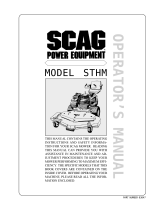 Scag Power Equipment STHM Three-Wheel Rider User manual
Scag Power Equipment STHM Three-Wheel Rider User manual
-
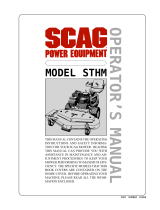 Scag Power Equipment STHM Three-Wheel Rider User manual
Scag Power Equipment STHM Three-Wheel Rider User manual
-
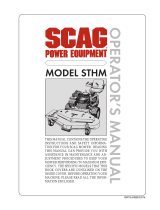 Scag Power Equipment STHM Three-Wheel Rider User manual
Scag Power Equipment STHM Three-Wheel Rider User manual
-
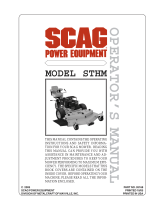 Scag Power Equipment SM-72A User manual
Scag Power Equipment SM-72A User manual
-
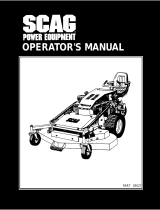 Scag Power Equipment Magnum III User manual
Scag Power Equipment Magnum III User manual
-
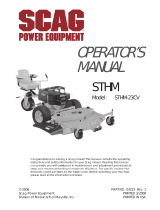 Scag Power Equipment STHM Three-Wheel Rider User manual
Scag Power Equipment STHM Three-Wheel Rider User manual
-
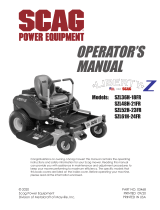 Scag Power Equipment SZL36H-18FR User manual
Scag Power Equipment SZL36H-18FR User manual
-
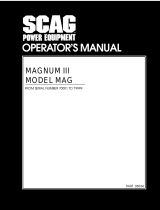 Scag Power Equipment xxx70001-xxx79999 serial number range User manual
Scag Power Equipment xxx70001-xxx79999 serial number range User manual
-
Scag Power Equipment SWZ48-15KH User manual
Other documents
-
Catskill Craftsmen 3325 Installation guide
-
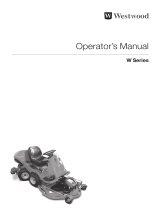 Westwood W16-4WD User manual
Westwood W16-4WD User manual
-
Hitachi CM14E Owner's manual
-
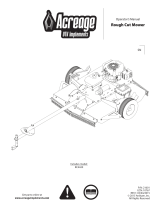 EarthQuake RC4432 MOWER ROUGH CUT 44 INCH BRIGGS User guide
EarthQuake RC4432 MOWER ROUGH CUT 44 INCH BRIGGS User guide
-
COX 8900 & 8904J 2000 – 2004 Owner's manual
-
Troy-Bilt 31/2 HP User manual
-
Snapper SGV13320KW User manual
-
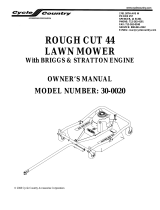 Cycle Country 30-0020 Owner's manual
Cycle Country 30-0020 Owner's manual
-
Seizmik 04017 User manual
-
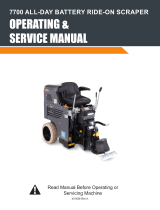 National Flooring Equipment 7700 Operating & Service Manual
National Flooring Equipment 7700 Operating & Service Manual







































































